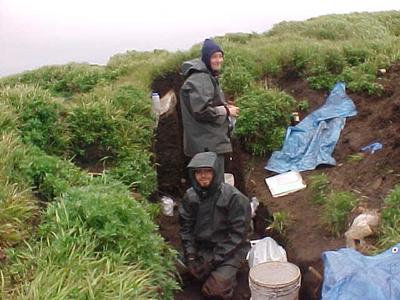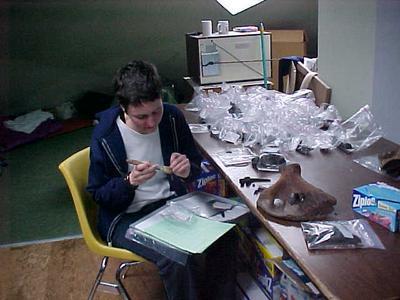4 July, 2002
The 4th of July was celebrated in Wales with a large group of people
shooting their rifles into the Bering Sea. There was another
celebration with a BBQ, but since it was raining they had it in the
Dome. Our little apartment/lab now smells like a hamburger (we are
upstairs).
We have been working on level one of tel. 079, Kurigitavak Mound. In
archaeology, you have to make contour maps as you excavate. This
excavation is now in its sixth field season, so there is documentation
to study. It is still not easy to determine when we hit
new levels, but we do go by the maps. I started on a unit (a square
meter area); it is then made into quadrants (northeast, northwest,
southeast, southwest). This enables us to be more exact when an
object is found. The more data collected the more interpretation will
result. I worked on S3W1 northwest quadrant and then the southeast
quadrant. I did not find much, I think because it is still on the top
layer. We have only begun to excavate. I am pretty sure we will find
a great deal more as we go to lower levels. I did find small pieces
of ceramic and a few pieces on bone (faunal). I also found small
lithics (points). It is very important to be aware of the different
soils (hard sod, clay, sandy etc.) and colors. These a! re all
indications of new areas we may be looking for. Once again we are
expanding on the house that was excavated last field season. Another
vital aspect of archaeology is journal writing. It is necessary to
keep a day by day journal. We must include all aspects of what we are
discovering. We have to describe the soil, and the texture and color.
We have to discuss what we find and where. For example: in S3W1 if we
found a great deal of ceramic (pottery), it may mean this is where
the cooking and eating was taking place. If we found more artifacts
in an area, it may mean this is where they made their hunting tools.
Artifacts are worked substances that are used for hunting, cooking,
sewing etc. In the Arctic region, great deals of the artifacts are
made from walrus ivory. Ornaments and jewelry are also mad from
ivory. We sometimes find baleen, but this is difficult to keep
because of the texture. Baleen is from the Bowhead Whale. When the
whale eats it collects a great deal in ! its mouth and then lets the
water sift out through the substance known as baleen (it is almost
very fine strands of hair compacted together in a very hard
substance. Back to journal writing, it is the writing that is the
documentation of what we are doing in the field. Roger Harritt will
be studying our journals as a very important aspect of the
excavation. He will refer to various dates and descriptions when we
find certain items.
Well, on to Friday, hopefully the weather will cooperate; but then
again we are in Bering Sea area. The weather takes over.

Amy is working in the Dome sorting and writing her paperwork.

Jim and Teresa worked together in the trench on the other side of the mound. Margie would work there later and Jim joined us on the mound. They were going way down in the trench because of many good sample finds.

These two guys came down from the mountain to feed and see what we were doing one fine afternoon.

Pictured here is a whale scapula or shoulderblade. It was amazing how many we found, as well as the different sizes.

At night when we sorted, it was important to clean the samples. This prevented decay as well as help preserve them better. Teresa is pictured here taking her turn.
Contact the TEA in the field at
.
If you cannot connect through your browser, copy the
TEA's e-mail address in the "To:" line of
your favorite e-mail package.
|
